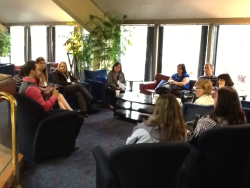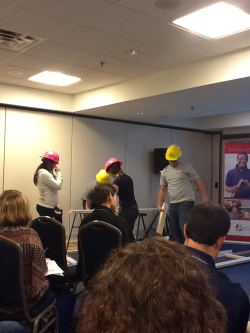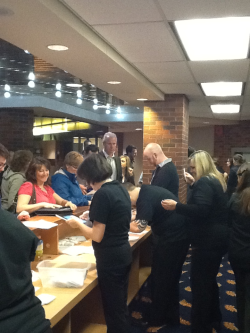Learning disabilities are complex, impacting individuals in many different ways. Imagine struggling the mental juggling that's required every day - remembering the sequence of events in a story or doing math calculations. Those functions are linked to working memory, and when yours is weak, many things become a challenge.
Here's a great article on working memory and why it matters from the National Center for Learning Disabilities.
The Bridgeway Team
What is Working Memory and Why Does it Matter?
By Annie Stuart
Remember the day when someone rattled off a phone number while you just hoped against hope you'd recall the string of digits as you were dialing? That was working memory toiling away. With the advent of cell phones, you may no longer use it this way very often. But working memory still plays a central role in learning and our daily lives.
If working memory is weak, it can trip up just about anyone. But it really works against a child with learning disabilities (LD). You can take steps to help a child with weak working memory, whether or not LD is a part of the picture. Start by understanding what working memory is all about.
What is working memory?
Working memory is your brain's Post-it note, says Tracy Packiam Alloway, Ph.D., assistant professor of psychology at the University of North Florida in Jacksonville, Florida. "It makes all the difference to successful learning," she says.
You can think of working memory as the active part of your memory system. It's like mental juggling, says H. Lee Swanson, Ph.D., distinguished professor of education with the Graduate School of Education at the University of California, Riverside. "As information comes in, you're processing it at the same time as you store it," he says. A child uses this skill when doing math calculations or listening to a story, for example. She has to hold onto the numbers while working with them. Or, she needs to remember the sequence of events and also think of what the story is about, says Swanson.
Brief by design, working memory involves a short-term use of memory and attention, adds Matthew Cruger, Ph.D., neuropsychologist with the Learning and Diagnostics Center at the Child Mind Institute in New York City. "It is a set of skills that helps us keep information in mind while using that information to complete a task or execute a challenge," he says. Working memory is like a foundation of the brain's
executive function. This is a broad and deep group of mental processes. They allow you to do things like plan ahead, problem solve, organize, and pay attention.
1 "Working memory helps us stay involved in something longer and keep more things in mind while approaching a task," says Cruger. "And, how can you plan ahead if you don't use working memory to keep your goal in mind, resist distractions, and inhibit impulsive choices?"
But if you struggle with working memory, pieces of information may often evade your grasp like a quickly evaporating dream. You find yourself stripped of the very thing you need most to take action.
Types of Working Memory
"You can't overemphasize how often working memory is used in the classroom," says Cruger. Children (and adults) use two main subtypes of working memory throughout the day. Both develop at a similar rate during childhood, and often reach their highest level in early adulthood.
2 Verbal (auditory) working memory taps into the sound (phonological) system. Silently repeating that phone number while dialing makes use of this system. "And anytime kids are expected to follow a multi-step set of oral instructions, they are using these working memory skills," says Cruger. If there's a weakness, however, they may not be able to keep the instructions in mind while working with them, he says. This is true even when they fully understand what to do. Other tasks that require use of this type of working memory are learning language and comprehension tasks.
3 Visual-spatial working memory uses a kind of visual sketchpad of the brain. It allows you to envision something, to keep it in your "mind's eye." Students use this skill to do math and to remember patterns, images, and sequences of events.
4 They might use it to visualize the layout of the classroom during the first couple of weeks of school, says Cruger. "A teacher says, 'Once you're done with this, go to the center area, take something to do and then go to this table and work on this,'" he says. "That involves multiple steps where the child is negotiating himself in the world." If not identified, a deficit of this type is ripe for misunderstanding, he says. For example, it might seem as though a child is simply not paying attention.
How is working memory linked with learning and LD?
Working memory can be a central problem for many people with Attention-Deficit/Hyperactivity Disorder (AD/HD), says Cruger. Or, it may be one of many things that is weak among a set of attention and executive functioning problems.
Those with weak working memory are likely to have learning disorders, too. In a government-funded study, Alloway and colleagues tested more than 3,000 grade school and junior high children in the U.K. They found that one in 10 had very poor working memory.
This turned out to be a reliable indicator of who would struggle in the classroom, she says. In fact, when following up six years later, they found working memory to be a more powerful predictor than IQ when it comes to learning.
5 "Ninety-eight percent with poor working memory had very low scores in standardized tests of reading comprehension and math."
These weaknesses may show up later, when executive skills of comprehension and analysis come into play, says Swanson. "Schools do a pretty good job of drill and repetition and teaching kids phonics, but when you get into things like comprehension, it can begin to fall apart."
And, if a child has a learning disability, weak working memory can add insult to injury. For example, a fifth grader who is still sounding out words while reading is relying heavily on working memory to help compensate. This puts a huge tax on the working memory system, says Cruger. At this stage, you want reading to be more automatic. You want to be able to look at a word and recognize it, he says, and not have to recruit attentional or working memory resources to the task. But for a child who needs to compensate but can't rely on working memory, the process can become all the more painful.
This weakness may compound things, especially for those with LD, says Alloway. "I've worked at schools where the average 10-year-old can remember and process four pieces of information, but one with poor working memory can look like an average 5-year-old," she says. "For this child, the teacher talks too fast, making it hard to keep up. So the child may eventually start disengaging altogether."
Combine these challenges with high anxiety, which also puts demands on working memory, and it becomes more than a double whammy. "Your emotional state can play a role in working memory performance, which can in turn influence performance on tests," says Alloway.












